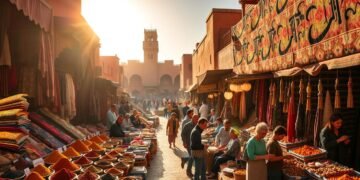Moroccan tile showcases traditional design that brings elegance to any setting. Recognized for its vivid colors and distinctive patterns, this tile is frequently incorporated in residences to create beautiful backsplashes, flooring, and decorative walls. Featuring options like hand-painted Zellige and elaborate mosaic designs, each piece is crafted by hand and narrates a unique story. Investigate the captivating array of Moroccan tiles and see how they can elevate your home décor.
Historical Significance of Moroccan Tile
Moroccan tile has significantly influenced the architecture of historical structures, showcasing impressive craftsmanship through designs like zellige tiles, geometric patterns, and the distinctive eight-pointed star. These tiles reflect a rich blend of cultures, as artisans combined influences from Spain, Africa, and the Middle East, evident in creations such as Fez medina tiles and elaborate floral arabesque motifs.
Historical events, like the trade routes that flourished in the region, impacted production methods, leading to the use of techniques like hand-cut mosaics and the creation of bejmat tiles with their slightly pitted surface. Today, this vibrant history enhances the appreciation for these tiles in modern design, as they feature prominently in spaces like kitchens for backsplashes, bathrooms as stylish floor tiles, and living areas where basketweave mosaic and fig leaf mosaic add character to feature walls.
The allure of Moroccan tile continues with its artisanal quality, whether through colorful cement tiles or the intricate detailing of Alhambra mosaics, reinforcing its timeless charm and significance.
Artistic Styles in Moroccan Tile
Alhambra Mosaic Influence
Alhambra mosaics inspire contemporary Moroccan tile designs through their unique elements, such as intricate geometric patterns found in handmade zellige and mortar tiles. The eight pointed star motif and floral arabesque patterns are prominent in modern creations like the mellah mosaic and fig leaf mosaic tiles. These designs showcase the rich history of Moroccan artistry.
For instance, tiles like the fez medina and medina lounge feature captivating tile patterns that reflect historical influences while employing modern techniques. Artisans craft elegant installation options for kitchens and bathroom floors with glazed terracotta, bejmat, and cement tiles. The incorporation of embellishing laces in star mosaic and basketweave mosaic tiles adds depth to feature walls. With each handmade tile, a slightly pitted surface is formed, enhancing the uniqueness of each piece.
Diamond Mosaic Tile Patterns
Diamond Mosaic Tile Patterns display geometric designs and vibrant colors, often crafted from hand-cut zellige and glazed terracotta. Tiles featuring designs like the eight-pointed star or floral arabesque create a visually striking aesthetic that enhances the character of kitchens and bathrooms. Many offer unique installation options, serving as backsplashes or for bathroom use. Historically rooted in Moroccan art, they are reflected in designs like the fez medina and alhambra mosaic.
The richhistory and craftsmanship affect modern applications, including bejmat tiles or patterns found in mellah mosaic and basketweave mosaic. These tiles can beautify feature walls or add depth to bathroom floors. Designers can blend elements like Moroccan sea salt or embellished laces to merge old-world charm with current trends, making these tiles suitable for both interior and exterior projects.
With a variety of patterns, including star and cross or fig leaf mosaic, they create beautiful arrangements that resonate in contemporary spaces. Their slightly pitted surfaces offer a unique texture, enhancing any design scheme.
Types of Moroccan Tile
Traditional Moroccan Tile
Traditional Moroccan tile features colorful and intricate designs, often seen in styles like zellige and cement tiles. These tiles showcase geometric patterns, such as the iconic eight-pointed star, star and cross, and floral arabesque motifs. The craftsmanship includes hand-cut techniques and embellished laces, creating unique effects that make each piece standalone art.
The rich history of Morocco influences these designs, reflecting the country’s diverse culture through patterns like the Fezmedina and mellah mosaic, developed over centuries. In modern interiors, these tiles can be applied to kitchen backsplashes, as patterned floor tiles, or in bathrooms, bringing history into contemporary settings. Their adaptability allows for installation on feature walls, while upholding authenticity through traditional patterns such as basketweave mosaic and fig leaf mosaic.
Options like glazed terracotta provide a slightly pitted surface that adds character, while being practical for variousapplications, making them ideal for both aesthetic appeal and functionality in homes.
Luxe Mosaic Tile Options
Luxe mosaic tile options stand out for their unique designs and quality materials like glazed terracotta. Hand-cut tiles feature stunning motifs such as the eight pointed star, floral arabesque, and intricate patterns of zellige tile. These tiles, including Fez Medina and Alhambra mosaic, bring a vibrant aesthetic to kitchens and bathroom floors, especially as backsplashes or on feature walls. The handmade nature adds character, with embellishing laces enhancing their elegance.
When consideringinstallation, looking at specific tile patterns, including the patterned floor tile and basketweave mosaic, is important. The slightly pitted surface of bejmat tiles makes them slip-resistant, ideal for high-traffic areas.
Additionally, mosaics like the medina mosaic tile can fit various applications based on their durability and design. Homeowners should focus on both functionality and style, ensuring their selected designs, like a star and cross or fig leaf mosaic, complement their overall decor. Cement tiles are also a versatile option, thriving in outdoor spaces and adding charm to any area.
Applications of Moroccan Tile
Interior Design
Moroccan tile enhances interior design projects with intricate patterns like zellige and floral arabesque designs. These tiles often feature geometric motifs, such as the eight-pointed star or star and cross, making spaces like kitchens and bathrooms more appealing. Hand-cut mosaic options, including mellah and medina mosaic tiles, serve as striking elements for kitchen backsplashes or feature walls.
The variety in designs, from glazed terracotta to cement tiles, harmonizes with both traditional and modern aesthetics, allowing for inventive installations. When choosing Moroccan tiles, considerations include the aesthetic vision and practical aspects, such as a slightly textured surface for improved grip or a polished finish for a sleek contemporary look. Styles like basketweave mosaic or fig leaf mosaic add texture and depth to floors, increasing their visual attraction and functionality, particularly in bathrooms.
Outdoor Spaces
Moroccan tile offers unique benefits for outdoor spaces due to its handmade quality and artistic designs, such as floral arabesque and eight-pointed star patterns. Options like zellige and cement tiles feature slightly pitted surfaces that enhance slip resistance, making them suitable for patios and gardens. The colorful and geometric patterns, including star mosaic and basketweave mosaic, transform dull areas into vibrant features.
Climate can affect the longevity of these tiles; for example, glazed terracotta zellige tiles may need sealing in wet areas to prevent damage.
Additionally, bejmat tiles are durable and handle heavy foot traffic well, while those exposed to harsher conditions might need more maintenance. The medina lounge and fig leaf mosaic tile designs add charm to outdoor settings, boosting overall aesthetic appeal. With careful installation on surfaces like bathroom floors or kitchen backsplashes, these tiles can create stunning visual effects, combining beauty with practicality in outdoor areas.
Cost Considerations for Moroccan Tile
Total Cost of Installation
The total cost of installing Moroccan tile, such as zellige and mosaic tiles, varies based on several factors. The type of tile selected influences expenses; for example, detailed designs like floral arabesque or Alhambra mosaic typically require more labor due to the complexity of the installation.
Hand-cut options, such as the eight-pointed star or mellah mosaic, may also incur higher installation costs compared to simpler patterned floor tiles because of their unique designs and craftsmanship. Alongside tile prices, which range from hand-painted to glazed terracotta, other expenses must be factored in. For instance, labor for installation, materials like mortar or adhesive, and any necessary tools contribute to the total cost. If a homeowner opts for cement tiles for a bathroom floor or adds a kitchen backsplash, they should also consider maintenance, such as sealing bejmat tiles periodically.
Additionally, specialized installations for feature walls or basketweave mosaic can drive up labor costs. Being aware of all these elements assists in determining the overall budget for a Moroccan tile project.
Factors Affecting Cost
The price of Moroccan tile varies due to several factors related to materials and craftsmanship. Handmade options, such as zellige and bejmat tiles, often use glazed terracotta that features intricate geometric patterns. These tiles may have a slightly pitted surface, contributing to their unique charm but requiring more labor to produce, which raises their price.
Size and complexity are also significant; for instance, a floral arabesque or an eight-pointed star design usually costs more than simpler patterns like the star and cross or fig leaf mosaic. Larger mosaics, such as the mellah or alhambra mosaic, may also need more materials and effort for installation. Moreover, the location where the tiles will be installed, such as kitchens or bathroom floors, influences overall pricing. Projects involving feature walls or elaborate installations, like a kitchen backsplash with basketweave mosaic and embellishing laces, can increase costs due to the time and expertise required.
Caring for Moroccan Tile
Cleaning Techniques
To clean Moroccan tile effectively, gentle methods are important to maintain its beauty and longevity. Mild soap mixed with water works well for regular maintenance, especially for hand-cut tiles like Zellige and cement tiles. For stubborn stains on glazed terracotta, a sponge can gently scrub the surface, being careful not to harm intricate designs like the eight-pointed star or floral arabesque patterns.
Luxe mosaic tiles, such as those with embellishing laces, may require extra care comparedto traditional tiles, as they are often more delicate. It is best to avoid bleach or harsh chemicals, which can damage surfaces and ruin the colors of mosaics, including the Fez Medina and Alhambra mosaic tiles.
Additionally, high pH cleaners may adversely affect the slightly pitted surfaces of bejmat tiles and basketweave mosaic designs. Regular sealing can protect bathroom floors and kitchen backsplash tiles while maintaining their appeal and ensuring easy cleaning for intricate tile patterns like the star and cross design.
Maintenance Tips
To keep Moroccan tile looking fresh, regular cleaning with a damp mop and mild detergent works well. Avoid harsh chemicals, as they can damage the slightly pitted surface of the tiles. To protect against wear and tear, applying a sealant can help shield hand-cut designs like zellige and mosaic tiles from moisture and stains, especially in kitchens and bathrooms. For tiles like the Fez Medina or floral arabesque, routine sealing ensures the elegant embellishing laces stay vibrant.
Using coastersor mats under heavy items can also prevent scratching on floor tiles, such as the basketweave mosaic or the star and cross patterns. Lastly, to maintain the shine of glazed terracotta, individuals can periodically buff the surface using a soft cloth, which will help preserve the luster of beautiful designs like the Alhambra mosaic or the medina lounge.
Purchasing Moroccan Tile
Where to Buy Moroccan Tile
Consumers can find authentic Moroccan tile at various online retailers that specialize in home décor and tiles. These shops typically offer a wide range of options, including hand-cut mosaics, Zellige tiles with geometric patterns, and unique designs like the Fez Medina and Alhambra mosaics. Local stores or specialty shops often showcase collections of these tiles, providing opportunities to see the designs and textures in person.
Buyers should look for descriptions that include details about the materials used, like glazed terracotta, and inquire about the crafting process, which often involves handmade techniques. Ensuring purchases come from reputable sources means checking for high-quality features such as slightly pitted surfaces on Zellige tiles and embellishing laces on pieces like the eight-pointed star or floral arabesque mosaics.
For those considering installations for kitchens, bathroom floors, or feature walls, popular options include the Mellah mosaic, the basketweave mosaic, and the patterned floor tile design, offering various styles to suit any taste.
Selecting Quality Variants
When assessing Moroccan tile variants, it’s important to look at attributes such as craftsmanship and material. High-quality mosaic tiles display hand-cut designs and distinctive tile patterns like zellige or geometric motifs. For instance, a glazed terracotta tile adorned with embellishing laces, such as the eight-pointed star or floral arabesque designs, can enhance kitchens or bathrooms. The materials chosen, such as bejmat or cement tiles, affect durability and aesthetic charm.
Bejmat tiles, being unglazed, offer more durability and are ideal for high-traffic areas, while cement tiles present vibrant colors that are perfect for feature walls or patterned floor installations. Ensuring that the selected tiles adhere to industry standards for craftsmanship and safety can confirm their quality.
Handmade tiles like those from Fez Medina or the Alhambra mosaic showcase artistry and can provide lasting beauty with proper care, enhancing areas such as kitchen backsplashes or bathroom floors.
Finally, exploring options like the basketweave mosaic or medina lounge tiles can enhance home décor.
Moroccan Tile in Modern Design
Blending Old and New Styles
The blending of traditional Moroccan tile designs with modern aesthetics can enhance the appearance of both interior and exterior spaces. Using glazed terracotta zellige tiles, which feature intricate geometric patterns like the eight-pointed star or floral arabesque, brings a touch of history to homes.
For example, pairing hand-cut mosaic tiles like the medina mosaic tile or the mellah mosaic with contemporary materials helps achieve a balance between complexity and simplicity. Designers can select a patterned floor tile or a sleek modern finish for kitchens, including options for kitchen backsplashes and taco-shaped tiles, to create stylish contrasts. Successful installations often incorporate the fig leaf mosaic or a basketweave mosaic in bathrooms, improving functionality while adding delightful visual interest. Combining cement tiles with traditional styles offers durability and adds a modern flair.
By thoughtfully merging old designs with new ideas, one can create spaces that are not only beautiful and unique but also rich in cultural significance. Whether it’s feature walls or classic flooring, each choice tells a story and provides new layers of charm.
FAQ
What are the key characteristics of Moroccan tile design?
Key characteristics of Moroccan tile design include vibrant colors, intricate geometric patterns, and azulejos (glazed ceramic tiles). Use bold hues like cobalt blue or sunny yellow, and incorporate star and floral motifs for a traditional look. Combine different tile shapes, like hexagons or zellige, for added texture and depth.
How can I incorporate Moroccan tiles into my home decor?
Incorporate Moroccan tiles by using them as backsplash in kitchens, tabletops, or bathroom walls. Create a feature wall with colorful tiles, or use patterned tiles as coasters and table runners for a vibrant accent. Consider adding them in smaller decor items like picture frames or plant pots for subtle touches.
Are Moroccan tiles suitable for outdoor use?
Yes, Moroccan tiles can be suitable for outdoor use if they are made from durable materials like ceramic or porcelain and are specifically rated for outdoor applications. Look for slip-resistant options for walkways or patios, and ensure they are sealed to withstand moisture and weather conditions.
What maintenance is required for Moroccan tiles to preserve their beauty?
To preserve Moroccan tiles, regularly sweep and mop with a pH-neutral cleaner. Avoid harsh chemicals, and seal the tiles every 2-3 years. For spills, promptly wipe with a damp cloth to prevent staining. Use soft pads under furniture to prevent scratching.
Where can I find authentic Moroccan tiles for purchase?
You can find authentic Moroccan tiles at specialty online retailers like Marrakech Design or Zelliges. Local tile shops and artisanal markets in Moroccan neighborhoods may also offer genuine options. Consider visiting sites like Etsy for handmade selections directly from artisans.


























